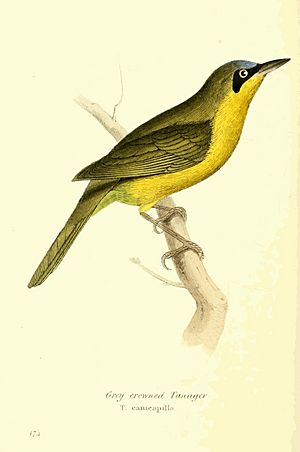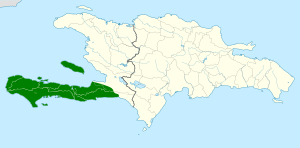Grey-crowned palm-tanager facts for kids
Quick facts for kids Grey-crowned palm-tanager |
|
|---|---|
 |
|
| Conservation status | |
| Scientific classification | |
| Genus: |
Phaenicophilus
|
| Species: |
poliocephalus
|
 |
|
| Range in green | |
The grey-crowned palm-tanager (Phaenicophilus poliocephalus) is a special type of bird found only on the Caribbean island of Hispaniola. This island is shared by two countries: the Dominican Republic and Haiti. Scientists consider this bird to be a Near Threatened species, which means its population is decreasing and it might become endangered if we don't protect it.
Contents
About Its Family and Name
The grey-crowned palm-tanager is related to another bird called the black-crowned palm-tanager. Sometimes, these two birds even have babies together! For a long time, scientists thought these birds belonged to a family called "true tanagers." But in 2017, they decided these birds were unique enough to have their own family, called Phaenicophilidae, or the Hispaniolan palm-tanagers.
There are three slightly different types, or subspecies, of the grey-crowned palm-tanager. These are P. p. poliocephalus, P. p. coryi, and P. p. tetraopes. Each subspecies lives in a slightly different area of Hispaniola.
What Does It Look Like?
The grey-crowned palm-tanager is about 18 cm (7.1 in) long, which is about the length of a regular pencil. It weighs around 27 g (0.95 oz), which is lighter than a single AA battery. Both male and female birds look very similar.
This bird has a deep gray color on its head, like a crown. It also has a black "mask" around its eyes with cool white spots. Its back and wings are a pretty yellow-green. The bird's throat is bright white, and the rest of its belly is the same dark gray as its head. The different subspecies have small differences in size or color. For example, P. p. coryi is a bit bigger and lighter overall.
Where Does It Live?
The grey-crowned palm-tanager lives only on the island of Hispaniola. The main type, P. p. poliocephalus, is found in southwestern Haiti and on a small island nearby called Grande Cayemite. In the Dominican Republic, you might find it in certain mountain areas.
The other subspecies live on specific islands close to Hispaniola. P. p. tetraopes lives only on Île-à-Vache, and P. p. coryi lives only on Gonâve Island.
These birds are quite adaptable! They can live in many different kinds of forests, from dry ones to wet ones, and from open areas to very dense woods. You can also spot them in tree farms, rural areas, and even in city gardens and parks. They can live from sea level all the way up to high mountains, about 2,400 m (7,900 ft) high.
Its Daily Life and Habits
Movement
The grey-crowned palm-tanager does not migrate. It stays in the same area all year long.
Feeding Habits
These birds usually look for food in pairs or small family groups. They often search for food from the middle branches of trees all the way up to the very top. Sometimes, they even join groups of different bird species that are foraging together.
Their main food is small arthropods, which are like insects and spiders. They also eat some fruit. They find insects mostly by looking closely at leaves, both living and dead ones.
Reproduction and Life Cycle
The breeding season for the grey-crowned palm-tanager is from May to July. They build a cup-shaped nest using small twigs. These nests are usually built high up in trees, sometimes as high as 9 m (30 ft) off the ground.
A female bird usually lays two to four eggs. After the young birds are old enough to fly, the family stays together for several months. Scientists are still learning more about how these birds raise their young.
Vocalization
The grey-crowned palm-tanager has a beautiful, long, and melodic song. It also makes a distinct "peee-u" call. However, there are not many recordings of their sounds available for people to listen to.
Status and Protection
The IUCN (International Union for Conservation of Nature) has listed the grey-crowned palm-tanager as Near Threatened. This means that while it's not in immediate danger, its numbers are dropping. The biggest threat to this bird is deforestation, especially in Haiti, where forests are being cut down very quickly.
Even though its habitat is shrinking, the palm-tanager is still common in the areas where forests remain. Because it can live in many different types of places, like gardens and parks, it might be able to handle some of the changes to its environment better than other birds. Protecting the remaining forests on Hispaniola is very important for this unique bird.
See also
 In Spanish: Cuatro ojos coronigrís para niños
In Spanish: Cuatro ojos coronigrís para niños


